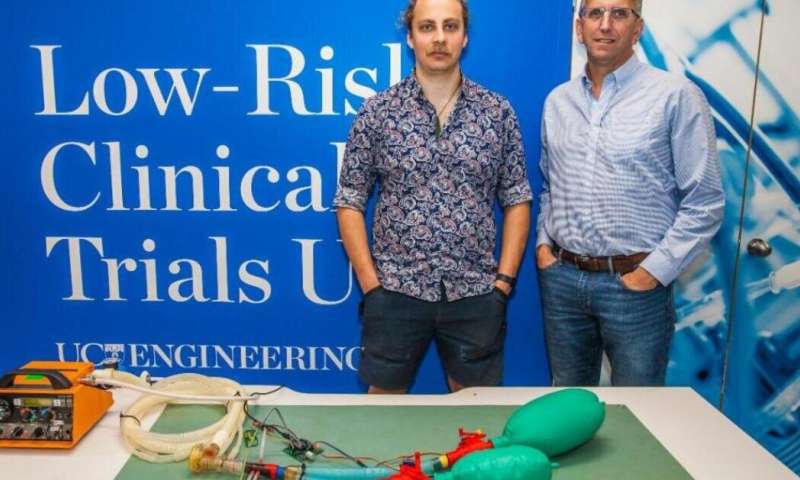Researchers help world to breathe free amid COVID-19 resurgence

Simple, low-cost technology developed by University of Canterbury (UC) engineers could save thousands of lives by doubling the capacity of ventilators in hospital intensive care units, boosting the capacity to treat overwhelming patient surges during COVID-19 outbreaks.
In many countries, the COVID-19 pandemic has overwhelmed hospital resources. Worldwide there is a shortage of ventilators because critically ill COVID-19 patients need mechanical ventilation to control breathing and allow recovery, sometimes for more than three weeks.
Distinguished Professor Geoff Chase, of UC’s Mechanical Engineering department and Center for Bio-Engineering, and UC Engineering Ph.D. student Lui Holder-Pearson, worked with Christchurch Hospital Senior Intensive Care Specialist Dr. Geoff Shaw, as well as engineers and senior doctors in Belgium and Malaysia, to create a device that allows two patients to use one ventilator safely and effectively.
“We see the rapid growth and stress on ICU and health resources building throughout Europe, and especially for our Belgian colleagues, and are thus distributing this first, fully tested version open access and freely, as promised, but still in the hope it never has to be used,” Professor Chase says. “The situation in Europe and the United Kingdom is hitting lockdown again, so it’s timely.”
UC researchers made a prototype and validated its safety and efficacy using mechanical lungs attached to two different types of ventilator at UC’s Mechanical Engineering department, with further testing at Christchurch Hospital.
The Active Close-loop Timed-in-series Inspiratory Valve or ACTIV system, as UC Ph.D. student Lui Holder-Pearson has named it, is ready for full release and use after these tests.
“We believe this can, and will, save countless lives internationally by doubling ventilator capacity and sparing doctors from having to make terrible end-of-life care choices,” Professor Chase says.
“It will help health systems to weather the COVID-19 pandemic storm when major outbreaks occur by increasing intensive care capacity. This is a clever technology. It’s a very simple, quickly implemented, low-cost, but high impact, solution. We developed them locally and have made them available with freely available software and designs to be 3-D-printed in hospitals internationally,” Professor Chase says.
This new technology uses mechatronics and modern manufacturing—such as 3-D printing—to create an actuated valve and several flow and pressure sensors. These sensors provide feedback as to the state of the ventilator, meaning the valve switches after every breath, diverting every second breath to a second patient. Enabling the single ventilator to ventilate one patient and then another is known as “in series” breathing.
Medical experts have regarded using a single ventilator for more than one patient, where they all breathe together or “in parallel,” as too risky. However, the Canterbury researchers have shown how this low-cost active breathing circuit concept, using “in series” breathing, allows it to be safe. Earlier in the pandemic, their concept was published in leading intensive care medicine journal Critical Care and has been accessed over 1000 times to date.
“This all-new approach will require very little change to current clinical ventilation practice,” Professor Shaw says. “The device and active breathing circuit we’ve proposed is a technology extension that enables each patient connected to a ventilator to be treated individually by the machine, instead of breathing in parallel at the same time, which is higher risk to both patients. We believe our technology could also lead to improvements in other areas of ventilation care.”
The team collaborated with ICU clinicians in Christchurch, Malaysia and Belgium on testing and proof of concept, with the research led from UC, New Zealand. This international team shares over 15 years of joint research on intensive care medicine, creating novel innovations that have significantly improved care and outcomes for many patients.
Source: Read Full Article
